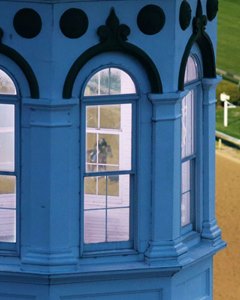Kentucky Approves Race Dates for 2018


Off a strong September of Thoroughbred racing in the state, the Kentucky Horse Racing Commission Oct. 17 approved a 2018 racing schedule similar to this year's schedule.
In both 2014 and 2015 Kentucky Downs pursued additional dates for the 2015 and 2016 race years but was rebuffed. After no public debate at Tuesday's meeting on a possible expansion of the successful meet, this year the Franklin, Ky. track again was approved for five September race dates.
In terms of the Kentucky Thoroughbred racing calendar, September has seen the most change and requests for changes in the past few years with Kentucky Downs pursuing added race dates and—in a change approved in 2012 and launched in 2013—Churchill Downs taking over September racing from Turfway Park.
Both Kentucky Downs and Churchill enjoyed strong performance at their September meets this year. Kentucky Downs saw a 34.2% jump in all-sources handle to a record $30.25 million for its five race days, while Churchill registered a 13.9% improvement in all-sources handle for its 11 days of racing that concluded Oct. 1.
Money generated for the Kentucky Thoroughbred Development Fund by historical racing in the state has helped keep horses in Kentucky. In fiscal year 2017, 73% of the $5.87 million generated by historical racing in the state for the Kentucky Thoroughbred Development Fund came from Kentucky Downs. Aside from that, Kentucky Downs also has contributed purse money to Ellis Park that has helped keep horses in Kentucky. And horses competing at the short Kentucky Downs meet are staying in-state.
"By working with the horsemen and Ellis Park, I think Kentucky Downs has been able to have a significant impact on the year-round circuit," said Kentucky Downs president Corey Johnsen. "One only needs to look at the opening weekend of the fall meet at Keeneland, where 10 of the first 30 winners came from Kentucky Downs."
At Tuesday's KHRC meeting at the Kentucky Horse Park, Churchill Downs racetrack president Kevin Flanery said the current race schedule also is contributing to horsemen staying in Kentucky and attracting new horsemen to the state.
Kentucky Downs' field size declined 4.7% from last year but still registered an impressive 10.44 starters per race while Churchill Downs' field size in September improved 4% to 8.88. Purses at Kentucky Downs improved 8.8% to $8.4 million and purses at Churchill September improved 11.1% to $4.6 million.
For the calendar year through Oct. 15, purses at Kentucky tracks are up 4.2% compared with the same period last year to $63.5 million.
As for racing dates in 2018:
* Turfway Park is scheduled to race 40 days from Jan. 1- March 31, with an option for nine additional race dates. Later in the year Turfway is approved to race 21 dates from Nov. 28-Dec. 31.
* Keeneland is scheduled to race 16 days at its April 6-27 spring meet and 17 days at its Oct. 5-27 fall meet.
* Churchill Downs is scheduled to race 38 days from April 28-June 30 with Kentucky Derby day falling on May 5. Churchill is approved to again race 11 days Sept. 14-30, and then 21 days from Oct. 28-Nov. 25.
* Ellis Park is scheduled to race 30 days from July 1 to Sept. 3.
* Kentucky Downs' five race dates are set for Sept. 1-13. Like this year, Kentucky Downs is scheduled to begin its meet on the Saturday of Labor Day weekend, although in 2017 the track had to reschedule that opening date because of heavy rain.
Also at Tuesday's meeting, it was announced that Standardbred track Thunder Ridge withdrew its request for a 2018 racing license. KHRC general counsel John Forgy said in rewarding seven racing licenses for 2018, the commission will have two open licenses.
Keeneland and Churchill Downs are pursuing those open licenses in a joint venture that would see a Quarter Horse track and Standardbred track, which would each offer historical gaming, launched in 2019. Those efforts were not discussed at Tuesday's meeting.
